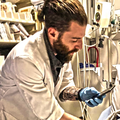@riley.august sorry, (enter to send was selected) anyways there are bluetooth stethoscopes, but as stated they are expensive, of course there must be a way to make them more accessible
 If you scroll up, I answered a similar question
If you scroll up, I answered a similar question
![]() When I made the stethoscope I had to buy rubber things for the earpeices. Have you considered modeling some in flex filament? They were not cheap.
When I made the stethoscope I had to buy rubber things for the earpeices. Have you considered modeling some in flex filament? They were not cheap.
 3D printing is challenging, as it's not cheap in quantity and of quite variable quality
3D printing is challenging, as it's not cheap in quantity and of quite variable quality
![]() ok guys, I went through your github...help me find the printable files...where are they?
ok guys, I went through your github...help me find the printable files...where are they?
 I did an article on "smart stethoscopes" a while back:
I did an article on "smart stethoscopes" a while back:

https://hackaday.com/2019/02/25/stethoscopes-electronics-and-artificial-intelligence/
Stethoscopes, Electronics, And Artificial Intelligence
For all the advances in medical diagnostics made over the last two centuries of modern medicine, from the ability to peer deep inside the body with the help of superconducting magnets to harnessing the power of molecular biology, it seems strange that the enduring symbol of the medical profession is something as simple as the stethoscope.
 I'm also fellowship trained in emergency ultrasound, and have done some work with Glia related to an open-source solution for live-streaming ultrasound images: https://github.com/jaffamd/streambox
I'm also fellowship trained in emergency ultrasound, and have done some work with Glia related to an open-source solution for live-streaming ultrasound images: https://github.com/jaffamd/streambox
 @Dan Maloney Thanks for that . link, excited to take a look!
@Dan Maloney Thanks for that . link, excited to take a look!
 @Tammo Heeren : I disagree that 'something is better than nothing'. Glia's goal is clinical equivalence. The third world is full of shitty handmedowns. We don't need to compromise the quality to reduce the cost on a 200 year old device!
@Tammo Heeren : I disagree that 'something is better than nothing'. Glia's goal is clinical equivalence. The third world is full of shitty handmedowns. We don't need to compromise the quality to reduce the cost on a 200 year old device!
 But doesn't realyy seem suitable for austere conditions
But doesn't realyy seem suitable for austere conditions
 Do you find that cost is the major problem or delivery of the equipment to the desired location? Looking at the areas you mentioned, it would seem that the technology is there (we use a lot of medical equipment from Israel here), but the method used to get it to the patients might be difficult. I am a nurse anesthetist and we use electronic stethoscopes, but I have found that analog versions are just as good.
Do you find that cost is the major problem or delivery of the equipment to the desired location? Looking at the areas you mentioned, it would seem that the technology is there (we use a lot of medical equipment from Israel here), but the method used to get it to the patients might be difficult. I am a nurse anesthetist and we use electronic stethoscopes, but I have found that analog versions are just as good.
 @Dan Maloney i'll be sure to check it out, thanks for the link
@Dan Maloney i'll be sure to check it out, thanks for the link
![]() resin 3d printing, from uv-cured materials, can be much more accurate/precise. my recent experiments achieved 0.5mm pitch M12 thread (camera lens thread) holding well without need to chase it with a tap.
resin 3d printing, from uv-cured materials, can be much more accurate/precise. my recent experiments achieved 0.5mm pitch M12 thread (camera lens thread) holding well without need to chase it with a tap.
 @brian dolge: We thought about modeling and injecting the ear pieces. In the end, we aren't looking to make it 100% 3d printed. just accessible. So we opted to use headphone ear tips
@brian dolge: We thought about modeling and injecting the ear pieces. In the end, we aren't looking to make it 100% 3d printed. just accessible. So we opted to use headphone ear tips
 makes sense they're easily findable
makes sense they're easily findable
 nice creative reuse
nice creative reuse
 @Thomas Shaddack : We're looking at how to incorporate SLA / mSLA, but the reality is that a rocket is easier to get into Gaza than a tub of resin would be. It'll be a while before that's a use case for us there.. We've been trying to figure it out.
@Thomas Shaddack : We're looking at how to incorporate SLA / mSLA, but the reality is that a rocket is easier to get into Gaza than a tub of resin would be. It'll be a while before that's a use case for us there.. We've been trying to figure it out.
![]() what about silicone casting into 3d-printed moulds? this could be a low-cost way performing economical distributed manufacture down to one-off lot sizes.
what about silicone casting into 3d-printed moulds? this could be a low-cost way performing economical distributed manufacture down to one-off lot sizes.
![]() to be candid, I print medical devices for our med ed sessions...the sterility was always an issue...fixed by fdm printing first, then lightly-brushing on resin and curing with UV to get a smooth, cleanable surface
to be candid, I print medical devices for our med ed sessions...the sterility was always an issue...fixed by fdm printing first, then lightly-brushing on resin and curing with UV to get a smooth, cleanable surface
 @Tarek Loubani Agreed. I was not talking about shitty hand-me-downs. Usually to achieve the last 5% costs a lot of time and money. This might not be necessary.
@Tarek Loubani Agreed. I was not talking about shitty hand-me-downs. Usually to achieve the last 5% costs a lot of time and money. This might not be necessary.
 Just a note on electronic stethoscope, an ECM or MEMS device "hears" differently than the ear, so I believe some transform is required in order to have the electronic stethoscope sound like a conventional stethoscope
Just a note on electronic stethoscope, an ECM or MEMS device "hears" differently than the ear, so I believe some transform is required in order to have the electronic stethoscope sound like a conventional stethoscope
![]() . o O ( what about loading the liquid resin into the rocket instead of the usual filling? )
. o O ( what about loading the liquid resin into the rocket instead of the usual filling? )
 @Don Randolph : Great question. We're using tech as one component of our plan to solve a humanitarian issue.. As Gibson said, the future is already here. Just not very evenly distributed
@Don Randolph : Great question. We're using tech as one component of our plan to solve a humanitarian issue.. As Gibson said, the future is already here. Just not very evenly distributed
![]() just yesterday I stumbled over a self-sterilizing trick using crystal violet added to a latex paint. 1000 ppm of this and some light and the colony forming units fell down like post-election hopes.
just yesterday I stumbled over a self-sterilizing trick using crystal violet added to a latex paint. 1000 ppm of this and some light and the colony forming units fell down like post-election hopes.
 Huh
Huh
 Interesting...
Interesting...
![]()
https://discovery.ucl.ac.uk/id/eprint/1497078/1/Hwang_Final%20revised%20manuscript.pdf
 @Thomas Shaddack : We have a model. That was Jennifer Glauche's initial idea and we ran with it in the prototypes. Just wasn't as easy to find silicon a and b in Gaza. We tried with construction silicone and those experiments failed.
@Thomas Shaddack : We have a model. That was Jennifer Glauche's initial idea and we ran with it in the prototypes. Just wasn't as easy to find silicon a and b in Gaza. We tried with construction silicone and those experiments failed.
 @Tarek Loubani How true.
@Tarek Loubani How true.
 Very cool @Thomas Shaddack
Very cool @Thomas Shaddack
 what can be found easily?
what can be found easily?
![]() In addition to the three new projects that the Glia team is currently working to develop, what other projects or ideas do you still see a big need for?
In addition to the three new projects that the Glia team is currently working to develop, what other projects or ideas do you still see a big need for?
![]() construction silicone does a lot of good job for me. if it failed, is it possible that there were factors that could be addressed?
construction silicone does a lot of good job for me. if it failed, is it possible that there were factors that could be addressed?
![]() On the tourniquet, I had a failure when I printed it in ABS, but succeeded with annealed(baked) PLA given that PLA is easier to print have you considered that route?
On the tourniquet, I had a failure when I printed it in ABS, but succeeded with annealed(baked) PLA given that PLA is easier to print have you considered that route?
 @Thomas Shaddack : Earplug mold https://github.com/GliaX/Stethoscope/blob/e855c117cb89579a6fecc31196cdc0a91cd9c292/source_files/earplug_mold.scad
@Thomas Shaddack : Earplug mold https://github.com/GliaX/Stethoscope/blob/e855c117cb89579a6fecc31196cdc0a91cd9c292/source_files/earplug_mold.scad
 What is a bigger issue, the noise from the chest piece or external noise that enters around the ear plug?
What is a bigger issue, the noise from the chest piece or external noise that enters around the ear plug?
 @Matteo Borri : Simple consumables and electronics.
@Matteo Borri : Simple consumables and electronics.
![]() @Tarek Loubani, was it the shrinkage during drying in the construction silicone, or what...we have multiple in-house tricks to get it to behave
@Tarek Loubani, was it the shrinkage during drying in the construction silicone, or what...we have multiple in-house tricks to get it to behave
 @Tarek Loubani have you or your team ever think in something like a mesh of devices to solve the qualified people problem, like having a mesh of stethoscopes centralized and the a couple of trained people dedicated to id, does it sound like something that it could be useful
@Tarek Loubani have you or your team ever think in something like a mesh of devices to solve the qualified people problem, like having a mesh of stethoscopes centralized and the a couple of trained people dedicated to id, does it sound like something that it could be useful
 So the idea is to have people print their own things?
So the idea is to have people print their own things?
 Anything that even resembles a construction supply or chemical supply is banned
Anything that even resembles a construction supply or chemical supply is banned
 We don't have a whitelist or a black list, either. so you kind of have to guess and see
We don't have a whitelist or a black list, either. so you kind of have to guess and see
 @Tarek Loubani May I ask Tarek, you wrote your goal is clinical equivalence. How do you want to prove it? by studies like you posted few minutes ago, or by some approval from 3rd sides like FDA clearence or CE mark, or something like that. Is it even possible?:)
@Tarek Loubani May I ask Tarek, you wrote your goal is clinical equivalence. How do you want to prove it? by studies like you posted few minutes ago, or by some approval from 3rd sides like FDA clearence or CE mark, or something like that. Is it even possible?:)
 @Israel Rosas : That's a great idea. We're not thinking of that for a stethoscope. Gaza actually has lots of doctors (4000 of them), and auscultation is so specific to the context that it wouldn't help much. But with ECG, this is our plan.
@Israel Rosas : That's a great idea. We're not thinking of that for a stethoscope. Gaza actually has lots of doctors (4000 of them), and auscultation is so specific to the context that it wouldn't help much. But with ECG, this is our plan.
![]() re crystal violet (and my more favorite for disinfectant use, brilliant green, its sister triarylmethane with less annoying dye intensity), these are said to work even against MRSA bugs. i am trying to add it to printing resin and initial tests show it is soluble enough.
re crystal violet (and my more favorite for disinfectant use, brilliant green, its sister triarylmethane with less annoying dye intensity), these are said to work even against MRSA bugs. i am trying to add it to printing resin and initial tests show it is soluble enough.
 Do you have plans to tackle more complex equipment and its software? Would you hire professional reverse engineers for that or you reckon that the potential liability risk would be too high?
Do you have plans to tackle more complex equipment and its software? Would you hire professional reverse engineers for that or you reckon that the potential liability risk would be too high?
![]() we've got a printable tongue blade we're nearly done with, if you want
we've got a printable tongue blade we're nearly done with, if you want
 @Dr. Clint LeClair : I'd love to chat more about what you guys are doing. It was a combination of not being able to find the 2-part silicone, having irregular supplies fo construction silicone and just having a hard time controlling the conditions since electricity is VERY scarce
@Dr. Clint LeClair : I'd love to chat more about what you guys are doing. It was a combination of not being able to find the 2-part silicone, having irregular supplies fo construction silicone and just having a hard time controlling the conditions since electricity is VERY scarce
 @Marek Cermak : Yes, we certify our stuff via health canada, but we are currently working on CE. FDA is a distant goal because it's so expensive.
@Marek Cermak : Yes, we certify our stuff via health canada, but we are currently working on CE. FDA is a distant goal because it's so expensive.
 @brainstorm: We want more complex gear, but we're years away from needing to do much serious reverse engineering. In the pipeline is a pulse oximeter, which is in the clinical calibration stage (then validation, then release). the ECG is awaiting ethics review for validation. the tourniquet is already in wide clinical use. And next up, my moby dick... Dialysis.
@brainstorm: We want more complex gear, but we're years away from needing to do much serious reverse engineering. In the pipeline is a pulse oximeter, which is in the clinical calibration stage (then validation, then release). the ECG is awaiting ethics review for validation. the tourniquet is already in wide clinical use. And next up, my moby dick... Dialysis.
![]() a trick i stumbled over is using superglue for glass (butyl cyanoacrylate) as a tissue glue. Loctite Super Attak Glass Bond has promising datasheet. check glass glue datasheets if they are real butyl CA or if they are methyl/ethyl with plasticizer as it is much less suitable. i read some study by some american docs that compared med-grade tissue glues with tech-grade CA ones and the result was that the latter can be used when in resource-limited settings.
a trick i stumbled over is using superglue for glass (butyl cyanoacrylate) as a tissue glue. Loctite Super Attak Glass Bond has promising datasheet. check glass glue datasheets if they are real butyl CA or if they are methyl/ethyl with plasticizer as it is much less suitable. i read some study by some american docs that compared med-grade tissue glues with tech-grade CA ones and the result was that the latter can be used when in resource-limited settings.
 Sorry if this has already been answered you say 'having a hard time controlling the conditions since electricity is VERY scarce' do you take the 3D printer to Gaza/... , if electricity is a problem, do you use some kind of UPS for the printer?
Sorry if this has already been answered you say 'having a hard time controlling the conditions since electricity is VERY scarce' do you take the 3D printer to Gaza/... , if electricity is a problem, do you use some kind of UPS for the printer?
 Dialysis is not an engineering problem. It's going to cost probably a hundred or two thousand dollars to engineer it. But the clinical testing will be hard and expensive.
Dialysis is not an engineering problem. It's going to cost probably a hundred or two thousand dollars to engineer it. But the clinical testing will be hard and expensive.
![]() I'd love to take a swing at Dialysis
I'd love to take a swing at Dialysis
 @anfractuosity : Solar and batteries. But climate controlling things is much harder than just printing.
@anfractuosity : Solar and batteries. But climate controlling things is much harder than just printing.
 @Dr. Cl
@Dr. Cl
 @Dr. Clint LeClair : Me too. Our goal is to make a generic one that can accept disposables from all suppliers.
@Dr. Clint LeClair : Me too. Our goal is to make a generic one that can accept disposables from all suppliers.
![]() as a potential patient i'd take my shot at a noncertified gear in comparison to having none.
as a potential patient i'd take my shot at a noncertified gear in comparison to having none.
 essentially breaking vendor lock in
essentially breaking vendor lock in
 @Thomas Shaddack : That's seldom a real decision that's needed.
@Thomas Shaddack : That's seldom a real decision that's needed.
![]() How accessible are 3d printers and the needed materials for printing?
How accessible are 3d printers and the needed materials for printing?
![]() thought re climate control. phase-change materials, or leveraging nighttime when the solar energy influx is not there. basements also tend to be more stable in temperature than aboveground places.
thought re climate control. phase-change materials, or leveraging nighttime when the solar energy influx is not there. basements also tend to be more stable in temperature than aboveground places.
 We had to do that for the stethoscope, and it weighed very heavily on me. It's tremendous responsibility. And our patients deserve better than for us to give them substandard care.
We had to do that for the stethoscope, and it weighed very heavily on me. It's tremendous responsibility. And our patients deserve better than for us to give them substandard care.
 Willem Kolff did it with a washtub and a punch of cellophane sausage casing:
Willem Kolff did it with a washtub and a punch of cellophane sausage casing:

https://hackaday.com/2019/10/09/willem-kolffs-artificial-organs/
 @Thomas Shaddack : Great thoughts
@Thomas Shaddack : Great thoughts
![]() "essentially breaking vendor lock in"...definitely game...gotten a few cease and desist's for doing this in Medical Simulation conferences on "hacks"! lol
"essentially breaking vendor lock in"...definitely game...gotten a few cease and desist's for doing this in Medical Simulation conferences on "hacks"! lol
 i've tried to use mirrors to run a resin printer instead of the UV light
i've tried to use mirrors to run a resin printer instead of the UV light
 not worth doing power consumption wise
not worth doing power consumption wise
 most 3d printing stuff can run off a car battery if it has to
most 3d printing stuff can run off a car battery if it has to
 @Matteo Borri - Mirrors as in reflecting sunlight to cure the resin?
@Matteo Borri - Mirrors as in reflecting sunlight to cure the resin?
 WE use OPzS batteries. Lithium+ batteries are essentially impossible to get there in the sizes required
WE use OPzS batteries. Lithium+ batteries are essentially impossible to get there in the sizes required
 It seems like there are already inexpensive pulse ox devices, is it a similar situation as the stethoscope, they just do not work?
It seems like there are already inexpensive pulse ox devices, is it a similar situation as the stethoscope, they just do not work?
 @Dr. Clint LeClair : Our legal strategy is pretty simple: We take expired patents and use them to create the device. The closer we can stay within the patent, the easier we can defend against some stupid lawsuit
@Dr. Clint LeClair : Our legal strategy is pretty simple: We take expired patents and use them to create the device. The closer we can stay within the patent, the easier we can defend against some stupid lawsuit
![]() "most 3d printing stuff can run off a car battery if it has to"...this is why I was always so interested in converting 3d printers to dc motor with encoder to reduce the load...making it easier to use in electricity-challenged areas, more sustainably...but alas, not my area of expertise
"most 3d printing stuff can run off a car battery if it has to"...this is why I was always so interested in converting 3d printers to dc motor with encoder to reduce the load...making it easier to use in electricity-challenged areas, more sustainably...but alas, not my area of expertise
 @Jim: Correct. None of them are usable in regulated contexts. I bought a bunch and searched for the health canada / fda markings. Nope.
@Jim: Correct. None of them are usable in regulated contexts. I bought a bunch and searched for the health canada / fda markings. Nope.
 Another thing, Jim, is that our pulse ox isn't just oxy / deoxy hemoglobin. We added carboxy (carbon monoxide poisoning mainly) and methemoglobin (various poisons and metabolic diseases), since the two extra LEDs cost just a few bucks.
Another thing, Jim, is that our pulse ox isn't just oxy / deoxy hemoglobin. We added carboxy (carbon monoxide poisoning mainly) and methemoglobin (various poisons and metabolic diseases), since the two extra LEDs cost just a few bucks.
![]() @Tarek Loubani -totally get it and do the same for publicly presented material...its just presenting material vaguely usually gets the reps excitable
@Tarek Loubani -totally get it and do the same for publicly presented material...its just presenting material vaguely usually gets the reps excitable
![]() what are their wavelengths?
what are their wavelengths?
 Okay makes sense small incremental cost
Okay makes sense small incremental cost
 Right now, the monopoly is held by Nellcor for the finger probes. Even GE uses nellcor probes in lots of their pulse ox's
Right now, the monopoly is held by Nellcor for the finger probes. Even GE uses nellcor probes in lots of their pulse ox's
 @Tarek Loubani that sounds really interesting, have you got a project page somewhere on the pulse oximeter, curious how it works
@Tarek Loubani that sounds really interesting, have you got a project page somewhere on the pulse oximeter, curious how it works
 So by calibrating and releasing the data, we're going to be able to give researchers and other manufacturers the ability to make a finger probe of their own while knowing that it is calibrated
So by calibrating and releasing the data, we're going to be able to give researchers and other manufacturers the ability to make a finger probe of their own while knowing that it is calibrated
 I don't know yet, but I also suspect that nellcor's calibration data is almost all white-skinned people.
I don't know yet, but I also suspect that nellcor's calibration data is almost all white-skinned people.
![]() beware of many dyes. what looks like black or dark purple can have sharp fall in absorption when it comes to near-IR. a gotcha for anything like said oximeters.
beware of many dyes. what looks like black or dark purple can have sharp fall in absorption when it comes to near-IR. a gotcha for anything like said oximeters.
 @Tarek Loubani So, what's the challenge with the stethoscope? I must have missed it.
@Tarek Loubani So, what's the challenge with the stethoscope? I must have missed it.
 @Tammo Heeren : Challenge right now, you mean?
@Tammo Heeren : Challenge right now, you mean?
![]() ...or optical adapters.
...or optical adapters.
 @Tarek Loubani Yes. What keeps you from using in where you want to use it?
@Tarek Loubani Yes. What keeps you from using in where you want to use it?
 @Thomas Shaddack : Actually, we have to have ours dark otherwise we have problems. Our white pulse ox's were a problem.
@Thomas Shaddack : Actually, we have to have ours dark otherwise we have problems. Our white pulse ox's were a problem.
 FYI everyone, I'll post a transcript after the chat, in case you want to go back and grab a link.
FYI everyone, I'll post a transcript after the chat, in case you want to go back and grab a link.
![]() why not swap the led and sensor in the cheap chinese pulse ox's and spend more time in finding a way to getting the data logged (onto a cell-phone, for instance)?
why not swap the led and sensor in the cheap chinese pulse ox's and spend more time in finding a way to getting the data logged (onto a cell-phone, for instance)?
 @Tammo Heeren : Cost and military blockades in Gaza, cost in other places, remoteness in places like rural canada
@Tammo Heeren : Cost and military blockades in Gaza, cost in other places, remoteness in places like rural canada
 @Dr. Clint LeClair : But why? it costs $25 to make ours from scratch
@Dr. Clint LeClair : But why? it costs $25 to make ours from scratch
![]() there was even a problem with some trackballs/mice. unexplained failures at only a certain time of day. turned out the NIR went through the plastic when sun was shining into the office in a certain angle and overwhelmed the phototransistors on the rotation sensors.
there was even a problem with some trackballs/mice. unexplained failures at only a certain time of day. turned out the NIR went through the plastic when sun was shining into the office in a certain angle and overwhelmed the phototransistors on the rotation sensors.
 @Tarek Loubani So shipping stethoscopes to Gaza is not possible?
@Tarek Loubani So shipping stethoscopes to Gaza is not possible?
 Essentially impossible, though Israel would reply by saying medical devices aren't banned
Essentially impossible, though Israel would reply by saying medical devices aren't banned
 de facto, they are.
de facto, they are.
 @Tarek Loubani So your plan is to make them in Gaza.
@Tarek Loubani So your plan is to make them in Gaza.

 Lutetium
Lutetium
Discussions
Become a Hackaday.io Member
Create an account to leave a comment. Already have an account? Log In.